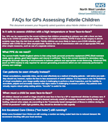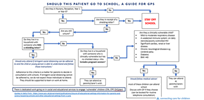Common paediatric questions
GPs and health visitors often ask our hospital paediatricians about common paediatric conditions and symptoms.
Emotional Mapping Guide

Coronavirus resources
Advice for assessing children with fever

You can find the answers to more questions about assessing febrile children in GP Practices in this FAQ document and a one-pager with advice for GPs.
Information on childhood flu vaccines

Answering questions about children's flu jabs during Covid-19
Childhood Influenza Vaccine Information
Managing illness in children during coronavirus

Traffic light approach to out-of-hospital management of illness in children during COVID-19 pandemic adapted from standard NICE guidance
Advice on when an unwell child should stay off school

A flowchart with advice for doctors, parents and carers about recognising symptoms of COVID-19.
Previous shielding advice for GPs

Shielding flow chart for GPs. From 1 August 2020 anyone who is at high risk (clinically extremely vulnerable) from COVID-19 no longer needs to shield.
Routine childhood vaccinations during coronavirus
Like many of the teams we work with, we were concerned about the drop in children's routine vaccinations during coronavirus. We have been working with the North West London children and young people transformation programme to create a bundle of resources for GP surgeries and health visitors. In the bundle you'll find examples of different ways surgeries are making it safe for children to be brought in for their vaccination appointments as well as a letter, email and text template to encourage parents to make or keep vaccination appointments.
Healthcare provider leaflet: Childhood vaccinations during COVID19
Flyer for parents: Advice on childhood vaccinations during coronavirus
Template letter, email and text
Translated resources
Existing translated resources: translated materials from reliable sources on Coronavirus, baby and maternity topics, child health and mental health.
We have been looking for translated resources to better support families in North West London, with up to 38% of residents not speaking English as their first language (2011 Census data). We'd love to hear from you about the resources, any other translated materials you use and what other translations would be useful, please get in touch.
General children's health resources
To better support primary care and community care health professionals, we have provided links below to useful information for some of these conditions.
Normal lower limb variants in children
This clinical review provides a quick reference guide on common lower limb abnormalities, including in- and out-turned toes, knock knees, bow legs and flat feet.
Primary care specialist infant formulae prescribing guidance
Our local community dieticians have produced guidelines for infant formulae prescribing.
Page four provides information on milk allergy in infants, and page 12 provides information on thickening formulae (like Enfamil AR) for babies with reflux.
Plagiocephaly and brachycephaly (flat head syndrome)
Umbilical hernia
Umbilical hernia, which is common but causes no problems, needs to be distinguished from paraumbilical hernia, which is unusual but can cause problems.
Phimosis in childhood
This paper gives information on when to be concerned by phimosis. Almost all boys have a non-retractile foreskin at birth, until at least aged two. Foreskin adhesions break down spontaneously. Most have a retractile foreskin by aged 10, 95% by aged 16. The foreskin and meatus appear healthy. Don’t be concerned by smegma (shed skin/secretions trapped under foreskin, ‘pearls’ or ballooning during micturition). This physiological phimosis does not require intervention/manipulation.
About this page
- Last updated
